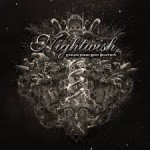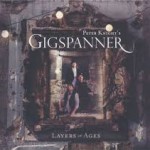A gig in an 800 year old church is not quite like your usual rock venue. Being an Anglican church, there’s still a bar, but it doesn’t sell any beer, only wine. And the acoustics are always wonderful, because medieval architects knew what they were doing. Peter Knight’s Gigspanner came to All Saints’ in Wokingham on a cold Friday night, and pulled more than double the crowd that had attended their gig in Reading back in November.
Though billed as a folk act, Gigspanner cannot be contained within narrow genre pigeonholes. The opening number was a case in point, beginning as an evocative classical-style violin solo which slowly morphed into a folk jig. The dark “Death and the Lady” took on a rock feel with Peter Knight on electric violin and some Dire Straits style guitar flourishes. The instrumental encore even had touches of jazz with everyone doing a solo.
The set drew heavily from their most recent album “Layers of Ages”. “Mad Tom of Bedlam” was an early highlight, as was “Bows of London”, the latter telling the tale of a drowned girl made into a violin exemplifying just how dark some traditional folk ballads can be.
It’s really Peter Knight’s show; his evocative and lyrical playing makes him to the violin what Steve Rothery is to the guitar, and he sings lead on the vocal numbers. Though guitarist Roger Flack and percussionist Vincent Salzfaas hahaved their time in the spotlight, including a Frampton Comes Alive moment with talk box guitar on “Mad Tom of Bedlam”, they both play more more of a supporting role. But what comes over strongly is the trio’s near telepathic understanding of each other on stage, such that often complex arrangements still retained an air of spontaneity.
Gigspanner are on tour for much of the next couple of months, though quite a few dates in small intimate venues have already sold out. If you get the chance to see them, go, even if you’re not a hard-core folk fan. They really are an excellent live band.


 The Norwegian six-piece pick up where they left off with last year’s “Demon”. The vibe resembles late period Talk Talk crossed with Storm Corrosion, sinister atmospheric soundscapes making prominent use of violin and the occasional irruptions of central European folk motifs. But be careful when you play it. The sound resembling modem noises at the very end of “Molok Rising” is a code which may destroy the universe.
The Norwegian six-piece pick up where they left off with last year’s “Demon”. The vibe resembles late period Talk Talk crossed with Storm Corrosion, sinister atmospheric soundscapes making prominent use of violin and the occasional irruptions of central European folk motifs. But be careful when you play it. The sound resembling modem noises at the very end of “Molok Rising” is a code which may destroy the universe. Lonely Robot is the project from John Mitchell of It Bites, Arena and Frost* fame, with a all-star supporting cast including Nick Beggs, Go West’s Peter Cox, Marillion’s Steve Hogarth, Heather Findlay and Kim Seviour. The end result is a varied but hugely impressive album. It goes from dense guitar-heavy industrial prog-metal to gorgeous ballads to uptempo 80s-style pop-rock, with imaginative arrangements that frequently veer off in unexpected directions.
Lonely Robot is the project from John Mitchell of It Bites, Arena and Frost* fame, with a all-star supporting cast including Nick Beggs, Go West’s Peter Cox, Marillion’s Steve Hogarth, Heather Findlay and Kim Seviour. The end result is a varied but hugely impressive album. It goes from dense guitar-heavy industrial prog-metal to gorgeous ballads to uptempo 80s-style pop-rock, with imaginative arrangements that frequently veer off in unexpected directions. The latest release by the Finnish masters of symphonic metal marks the studio début of lead singer Floor Jansen, and is also the first to feature celtic folk multi-instrumentalist Troy Donockley as a full member of the band. It’s rather heavier than their previous “Imaginaerum“, thought the straight-up metal numbers end up less interesting than the soaring ballads and folk-rock workouts. It might have done without the spoken word parts from the odious Richard Dawkins, though at least he’s talking about evolutionary biology here.
The latest release by the Finnish masters of symphonic metal marks the studio début of lead singer Floor Jansen, and is also the first to feature celtic folk multi-instrumentalist Troy Donockley as a full member of the band. It’s rather heavier than their previous “Imaginaerum“, thought the straight-up metal numbers end up less interesting than the soaring ballads and folk-rock workouts. It might have done without the spoken word parts from the odious Richard Dawkins, though at least he’s talking about evolutionary biology here. Gigspanner are an acoustic trio led by former Steeleye Span fiddle player Peter Knight, and Layers of Ages sees imaginative arrangements of traditional folk numbers. Though not an instrumental record, Knight’s evocative and lyrical violin playing is the heart of the sound, full of melody and emotion. Much like contemporary jazz, some modern folk has a lot of appeal for fans of progressive rock wanting to venture out of their comfort zone, and this record is a very good place to start.
Gigspanner are an acoustic trio led by former Steeleye Span fiddle player Peter Knight, and Layers of Ages sees imaginative arrangements of traditional folk numbers. Though not an instrumental record, Knight’s evocative and lyrical violin playing is the heart of the sound, full of melody and emotion. Much like contemporary jazz, some modern folk has a lot of appeal for fans of progressive rock wanting to venture out of their comfort zone, and this record is a very good place to start. Steven Wilson’s third release following the dissolution of Porcupine Tree is an ambitious concept album about isolation that’s drawn comparisons with Pink Floyd’s “The Wall” and Marillion’s “Brave”. He reins in the wind-driven jazz-rock elements in favour of more guitar-centred sound that’s closer to the spirit of Porcupine Tree than earlier solo releases, going from stripped-back minimalism that evokes XTC to dense layered prog-metal workouts. It’s perhaps not quite as consistently strong as “The Raven That Refused to Sing”, but nevertheless contains many powerful moments.
Steven Wilson’s third release following the dissolution of Porcupine Tree is an ambitious concept album about isolation that’s drawn comparisons with Pink Floyd’s “The Wall” and Marillion’s “Brave”. He reins in the wind-driven jazz-rock elements in favour of more guitar-centred sound that’s closer to the spirit of Porcupine Tree than earlier solo releases, going from stripped-back minimalism that evokes XTC to dense layered prog-metal workouts. It’s perhaps not quite as consistently strong as “The Raven That Refused to Sing”, but nevertheless contains many powerful moments.